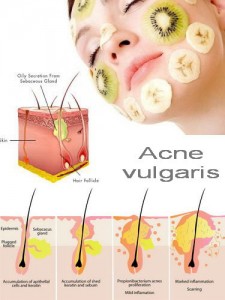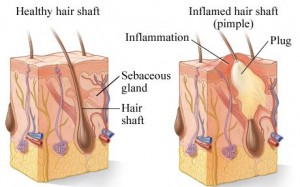Introduction:
Acne is a skin condition that affects most people at some time during their lives. It often (but not always) occurs during the teenage years, although it can affect children and older people as well. It causes spots to develop on the skin, usually on the face, back and chest. It can last for many months and sometimes years if left untreated. It is characterized by areas of seborrhea (scaly red skin), comedones (blackheads and whiteheads), papules (pinheads),pimples, nodules (large papules) and possibly scarring.
How does acne form?
Acne is a disorder of the pilosebaceous unit, which is made of a hair follicle, sebaceous gland, and a hair. These units are found everywhere on the body except on the palms, soles, top of the feet, and the lower lip. The number of pilosebaceous units is greatest on the face, upper neck, and chest. Sebaceous glands produce a substance called sebum, which is responsible for keeping the skin and hair moisturized. During adolescence, sebaceous glands enlarge and produce more sebum under the influence of hormones, also called androgens. After about age 20, sebum production begins to decrease. Sebum produced by the sebaceous gland combines with cells being sloughed off within the hair follicle thus clogging the hair follicle. When the follicle is full, the sebum spreads over the skin surface, giving it an oily appearance. When this process works correctly, the skin is moisturized and remains healthy.
Types of Acne:
Following are the most commonly recognized types of Acne:
- Acne vulgaris
- Acne rosacea
- Acne conglobata
- Acne cosmetica
- Acne fulminans
- Acne medicamentosa
What causes acne?
It is not clear why some people are more prone to acne than others. The exact cause of acne is unknown. But here are a few theories which could probably cause acne.
- Hormones – Hormones called androgens play an important role. Androgens increase in both boys and girls during puberty. Androgens make the skin’s oil glands get larger and make more sebum thus making the skin oilier than it needs to be. Androgens also increase because of hormonal changes related to pregnancy or starting or stopping birth control pills. Changing hormone levels in adolescent girls and adult women two to seven days before the start of the menstrual period also gives rise to acne in few women. Oily skin thus leads to more acne formation.
- Genetics – If your parents had acne, you may have inherited that tendency.
- Psychological & Emotional – Increase in stress levels in an individual may cause acne. Exam tensions, submissions, relationship heartbreaks etc are few of the kinds of emotional stress commonly experienced by a teenager.
- Medications – Some medicines (for example, epilepsy medication, prednisone, androgens taken as medicine, and lithium) can cause acne.
- Cosmetics – Cosmetics that have a greasy consistency may also clog pores. Water-based products are less likely to cause acne than oil-based makeup. Clogged pores contain dirt in them and eventually lead to acne outbursts.
- Physical causes – Friction caused by leaning on or rubbing the skin; harsh scrubbing, picking or squeezing blemishes. Pressure from bike helmets, backpacks, or tight collars. The pressure and friction induce the acne to break open thus leading to open lesions and superadded infection.
- Diet – The correlation between acne and foods is unknown. But intake of heavy fatty foods, oily food, junk food causes an increase in acne. Carbohydrate-rich foods – such as bread, bagels and chips, which increase blood sugar – may trigger acne.

Signs & Symptoms of Acne –
The common symptoms of acne are as follows –
- Blackheads (open comedones): small black or yellowish papules where dilated follicular outlets are filled with keratin.
- Whiteheads (closed comedones): have a similar appearance to blackheads but they have no visible follicular opening and have a white-coloured centre.
- Papules: inflammatory lesions that appear as small red bumps that may feel tender or irritated.
- Pustules: similar to papules but they have a white centre filled with pus (whitish-yellow substance containing dead cells, produced in response to bacterial infection).
- Nodules: deeper, larger inflammatory lesions that appear as hard lumps and build up under the skin’s surface.
- Cysts: large, pus-filled lumps that have a similar appearance to boils. These are the most serious type of skin lesion caused by acne and have the greatest risk of causing permanent scarring.
Home remedies for avoiding acne –
- Intake of plenty of fluids
- Intake of fruits and green leafy vegetables
- Scrubbing your face atleast once a week to clean the pores
- Washing your face twice a day with a gentle and mild face wash
- Keeping your face clear from dirt and dust as much as possible
Homoeopathic Approach in treating acne:
The fundamental problem in acne appears to be hormonal. Homoeopathy looks for the underlying causes of acne which are: hormonal imbalance, emotional stress etc thereby removing the ailment from the root level. Homoeopathic medicines help by improving your body’s hormonal system thereby reducing the tendency to form acne.
Acne treated in the conventional method is usually with the help of hormonal or steroidal supplements, topical ointments etc which have a temporary effect as long as the medicines are being taken. Homoeopathy helps in targeting the root cause of the problem and thereby treats the causes of acne from within. The main aim and objective of Homoeopathy has been to treat a person individually and relieve the patient of their symptoms from within.
Homoeopathy detoxifies the body by purifying the inner soul of the individual and hence completely relieves you of your complaints. Homoeopathy works at changing the pH of your body from acidic to alkaline thereby increasing the chances of a disease free environment in the body and thus reducing acne and its scars.
The homoeopathic treatment for acne is based on an extensive case study of the patient with regards to his/her characteristic symptoms, genetic predisposition, and their mental state. The total time taken for the treatment differs from person to person depending on the duration, intensity and frequency of the suffering, maintaining causes, susceptibility and general health of the patient.
The goal of homoeopathic treatment for acne is to identify the main cause for the occurrence of eruptions, and then to use the body’s own healing processes to transform the triggers into remedies. Acne is viewed differently in each person, because each person is afflicted in a different way. The health of the whole body, not just the superficial skin, is addressed to. Ultimately, homeopathy might create a cure for the acne by strengthening and balancing the hormonal system.
With the help of homoeopathy, the occurrence & severity of the eruptions can be reduced, the health of the individual can be enhanced thereby reducing the recurrences of acne and the need for topical treatment and steroids can be minimalized.
It is therefore advisable to choose Homoeopathy for treating your acne, because it treats the illness from within and removes it at its root level with a long term relief and without any side effects. Homoeopathy also controls the core tendency for acne formation by addressing the underlying hormonal imbalance and excessive oily tendency of the skin. Homoeopathy also helps in getting rid of the scars and reduces the hyperpigmentation which occurs after acne.
How Dr. Neha Seth can help you with your acne?
Dr. Neha Seth believes in giving the patient immediate relief with a shorter period of treatment. The prime line of treatment is to consider every disease to be a result of an allergy. The patient is first asked to get her Serum IgE levels done. The Serum IgE levels are expected to be high in every patient with symptoms. To know the allergen that is causing the disease, an allergy test is done. There are two types of allergy tests that are done – a blood test and a skin test. Usually the skin allergy test is asked for; reason being it costs 1/10th the cost of the blood test. With the help of the allergy test, the allergen is identified and treated accordingly. In cases of acne, it could be a food item like oily food, eggs, seafood, artificial food colours etc. The patient is immediately asked to stop consuming that food item which is the primary allergen. In case the allergen isn’t a food item and it is rather something like dust, pollen or chemicals like cosmetics etc, then the patient is expected to minimize the exposure as much as possible and keep away from the disease causing allergen. Since the maintaining and the causative factors are now known, homoeopathy works wonderfully once these causes are removed. The patient will therefore experience a reduction in the intensity and frequency of the symptoms as well as tolerance to factors such as dust, oily food, etc which trigger acne eruptions. The scars and blemishes can also be treated well with homoeopathy. Thus, Dr. Neha Seth can help you with your acne and definitely treat it giving you a long time relief from the confidence lowering blotch marks and scars. Have a blemish free skin!




